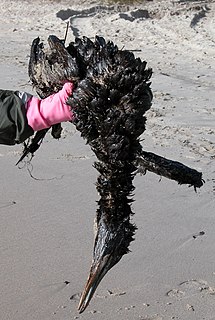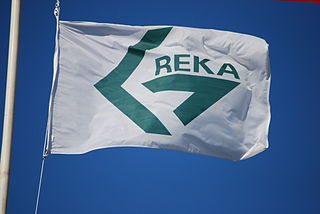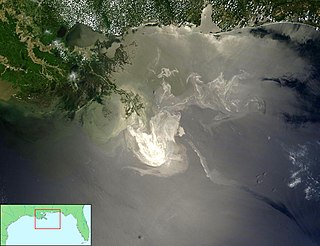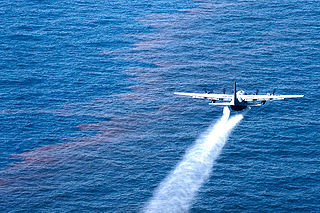This article needs to be updated.(October 2020) |
O'Brien's Response Management is the largest oil spill management company in the United States [1]
This article needs to be updated.(October 2020) |
O'Brien's Response Management is the largest oil spill management company in the United States [1]
Company founder Jim O'Brien fought his first oil spill in 1969 as an officer with the United States Coast Guard. In 1983 he retired to form his own company, O'Brien's Oil Pollution Service, known as "OOPS Inc.", in Slidell, Louisiana. [1] O'Brien soon gained fame in the 1980s as the "Red Adair of oil spill cleanup". [1] O'Brien also helped manage the Exxon Valdez oil spill of 1989. Following that event the United States enacted the Oil Pollution Act of 1990, requiring ships to carry sufficient insurance and hire a management company to handle any oil spill.
The company was bought by Seacor Holdings Inc. in 1997 and later renamed the O'Brien's Group, with O'Brien remaining as President. In 2004, the company helped clean 265,000 gallons of oil that spilled into the Delaware River from the Athos I. [1] [2] It oversaw recovery for the Murphy Oil Spill in Chalmette, Louisiana following Hurricane Katrina. [3] In July 2007, the company oversaw remediation efforts when refineries near Coffeyville, Kansas spilled 71,400 gallons of oil into the Verdigris River during a flood. [4] The company was also responsible for managing clean-up efforts after the Cosco Busan spilled 58,000 gallons of bunker oil into the San Francisco Bay on November 7, 2007. [1] It deployed approximately 1,500 workers to clean up that spill. [1]
As of 2007, O'Brien's Response Management represents approximately 400 shipping companies, 5,000 ships, and 200 oil and gas companies, and has worked on over 400 spills in the past three years. [1]

The Exxon Valdez oil spill occurred in Prince William Sound, Alaska, March 24, 1989, when Exxon Valdez, an oil tanker owned by Exxon Shipping Company, bound for Long Beach, California, struck Prince William Sound's Bligh Reef, 1.5 mi (2.4 km) west of Tatitlek, Alaska, at 12:04 a.m. and spilled 10.8 million US gallons (257,000 bbl) of crude oil over the next few days. It is considered the worst oil spill worldwide in terms of damage to the environment. The Valdez spill is the second largest in US waters, after the 2010 Deepwater Horizon oil spill, in terms of volume released. Prince William Sound's remote location, accessible only by helicopter, plane, or boat, made government and industry response efforts difficult and severely taxed existing response plans. The region is a habitat for salmon, sea otters, seals and seabirds. The oil, originally extracted at the Prudhoe Bay Oil Field, eventually affected 1,300 miles (2,100 km) of coastline, of which 200 miles (320 km) were heavily or moderately oiled.

The Delaware River is a major river on the Atlantic coast of the United States. It drains an area of 13,539 square miles (35,070 km2) in four U.S. states: Delaware, New Jersey, New York and Pennsylvania. Rising in two branches in New York state's Catskill Mountains, the river flows 419 miles (674 km) into Delaware Bay where its waters enter the Atlantic Ocean near Cape May in New Jersey and Cape Henlopen in Delaware. Not including Delaware Bay, the river's length including its two branches is 388 miles (624 km). The Delaware River is one of nineteen "Great Waters" recognized by the America's Great Waters Coalition.

An oil spill is the release of a liquid petroleum hydrocarbon into the environment, especially the marine ecosystem, due to human activity, and is a form of pollution. The term is usually given to marine oil spills, where oil is released into the ocean or coastal waters, but spills may also occur on land. Oil spills may be due to releases of crude oil from tankers, offshore platforms, drilling rigs and wells, as well as spills of refined petroleum products and their by-products, heavier fuels used by large ships such as bunker fuel, or the spill of any oily refuse or waste oil.

The Oil Pollution Act of 1990 (OPA) was passed by the 101st United States Congress and signed by President George H. W. Bush. It works to avoid oil spills from vessels and facilities by enforcing removal of spilled oil and assigning liability for the cost of cleanup and damage; requires specific operating procedures; defines responsible parties and financial liability; implements processes for measuring damages; specifies damages for which violators are liable; and establishes a fund for damages, cleanup, and removal costs. This statute has resulted in instrumental changes in the oil production, transportation, and distribution industries.

Plains All American Pipeline is an American publicly traded Master limited partnership in the oil pipeline transportation, marketing, and storage business in the United States, liquefied petroleum gas business in Canada, and natural gas storage business in Michigan and Louisiana. It owns about 37 million barrels of terminal and storage capacity and 15,000 miles (25,000 km) of crude oil pipelines.

The Prestigeoil spill occurred off the coast of Galicia, Spain, caused by the sinking of the 26 year old structurally deficient oil tanker MV Prestige in November 2002, carrying 77,000 tonnes of heavy fuel oil. During a storm, it burst a tank on November 13, and French, Spanish, and Portuguese governments refused to allow the ship to dock. The vessel subsequently sank on November 19, 2002, about 210 kilometres (130 mi) from the coast of Galicia. It is estimated that it spilled 60,000 tonnes or a volume of 67,000 m3 (17.8 million US gal) of heavy fuel oil. The spill polluted thousands of kilometers of coastline and more than one thousand beaches on the Spanish, French and Portuguese coast, as well as causing great harm to the local fishing industry. The spill is the largest environmental disaster in the history of both Spain and Portugal. The amount of oil spilled was more than the Exxon Valdez incident and the toxicity considered higher, because of the higher water temperatures.
CleanSeaNet (CSN) is a satellite-based monitoring system for marine oil spill detection and surveillance in European waters.

The Cosco Busan oil spill occurred at 08:30 UTC-8 on 7 November 2007 between San Francisco and Oakland, California, in which 53,569 US gal (202,780 L) of IFO-380 heavy fuel oil, sometimes referred to as "bunker fuel", spilled into San Francisco Bay after the container ship Cosco Busan, operated by Fleet Management Limited struck Delta Tower of the San Francisco–Oakland Bay Bridge in thick fog.

Greka Energy, legally HVI Cat Canyon Inc., is a privately held company engaged in hydrocarbon exploration principally in Santa Barbara County, California. Formed in 1999 after the acquisition and merger of several smaller firms, it is a subsidiary of Greka Integrated, Inc., a holding company headquartered in Santa Maria, California, and is wholly owned by Randeep Grewal.

The Morris J. Berman oil spill occurred on January 7, 1994, when the Morris J. Berman, a single-hull 302-foot-long barge, with the capacity to carry more than 3 million gallons of oil, collided with a coral reef near San Juan, Puerto Rico, causing the release of 750,000 gallons of heavy grade oil. The spill affected the tourism and fishing industries as well as wildlife along the shores of Puerto Rico, Isla de Culebra, and Isla de Vieques. The spill had major long-lasting impacts on the biological and natural resources of the entire Puerto Rican area. This spill was also the first to occur in U.S. waters after the passing of the Oil Pollution Act of 1990.

The Deepwater Horizon oil spill was an industrial disaster that began on April 20, 2010, in the Gulf of Mexico on the BP-operated Macondo Prospect, considered to be the largest marine oil spill in the history of the petroleum industry and estimated to be 8 percent to 31 percent larger in volume than the previous largest, the Ixtoc I oil spill, also in the Gulf of Mexico. The U.S. federal government estimated the total discharge at 4.9 million barrels. After several failed efforts to contain the flow, the well was declared sealed on September 19, 2010. Reports in early 2012 indicated that the well site was still leaking. The Deepwater Horizon oil spill is regarded as one of the largest environmental disasters in American history.

Corexit is a product line of oil dispersants used during oil spill response operations. It is produced by Nalco Holding Company, an indirect subsidiary of Ecolab. Corexit was originally developed by the Standard Oil Company of New Jersey. Corexit is typically applied by aerial spraying or spraying from ships directly onto an oil slick. On contact with the dispersant, oil that would otherwise float on the surface of the water is emulsified into tiny droplets and sinks or remains suspended in the water. In theory this allows the oil to be more rapidly degraded by bacteria (bioremediation) and prevents it from accumulating on beaches and in marshes.
Following is a timeline of the Deepwater Horizon oil spill for June 2010.

The Rena oil spill occurred off the coast of Tauranga, New Zealand in October 2011. The spill was caused by the grounding of MV Rena on the Astrolabe Reef. The Rena was a container ship and cargo vessel owned by the Greek shipping company Costamare Inc., through one of its subsidiary companies Daina Shipping, and chartered by the Mediterranean Shipping Company (MSC). The spill has been described as New Zealand's worst maritime environmental disaster.
The 1971 San Francisco Bay oil spill occurred when two Standard Oil Company of California tankers, the Arizona Standard and the Oregon Standard, collided on January 19, 1971, in the San Francisco Bay. The resulting 800,000 gallon spill, the largest in Bay Area history, threatened sensitive natural habitats both inside and outside the bay, including the Bolinas Lagoon, and contributed to the growth of activism against pollution, after thousands of bay area residents volunteered to clean up beaches and rescue oil soaked birds. A number of environmental organizations had their origins in the spill cleanup. Standard Oil spent more than $1 million in the clean-up.

The Deepwater Horizon oil spill occurred between April 10 and September 19, 2010 in the Gulf of Mexico. A variety of techniques were used to address fundamental strategies for addressing the spilled oil, which were: to contain oil on the surface, dispersal, and removal. While most of the oil drilled off Louisiana is a lighter crude, the leaking oil was of a heavier blend which contained asphalt-like substances. According to Ed Overton, who heads a federal chemical hazard assessment team for oil spills, this type of oil emulsifies well. Once it becomes emulsified, it no longer evaporates as quickly as regular oil, does not rinse off as easily, cannot be broken down by microbes as easily, and does not burn as well. "That type of mixture essentially removes all the best oil clean-up weapons", Overton said.
The Bass Enterprises Oil Spill was the largest in a series of oil spills that were caused by damage due to Hurricane Katrina in coastal industrial facilities. About 3.78 million gallons were spilled at the facility in Cox Bay, Louisiana, while an additional 461,000 gallons were spilled at the location in Point a la Hache, also in Louisiana.

The 2004 Taylor oil spill is an ongoing spill located in the Gulf of Mexico, around 11 miles (18 km) off the coast of the U.S. state of Louisiana, which resulted from the destruction of a Taylor Energy oil platform during Hurricane Ivan, and it is the longest oil spill in U.S. history. It was first brought to public attention when the contamination at the site was noticed in 2010 by those monitoring the nearby Deepwater Horizon oil spill. A later report by the Associated Press in 2015 challenged the estimates of the extent of the leak given by the company and the U.S. Coast Guard, which were then revised to be around 1000 times greater than initially reported.
CITGO Asphalt Refining Co. v. Frescati Shipping Co., 589 U.S. ___ (2020), was a United States Supreme Court case dealing with the responsibility of costs of cleanup resulting from a 2004 oil spill on the Delaware River near Paulsboro, New Jersey from the result of a hull rupture. The ship's owner, the Frescati Shipping Company, was responsible the costs of the cleanup, coming to more than US$140 million , but under the Oil Pollution Act of 1990, believed that Citgo, who had ordered the shipment, bore responsibly for the shipping route through shallow waters that led to the spill. After years of litigation, the Supreme Court ruled in its 7-2 decision that the contract language established between Citgo and Frescati established that Citgo would provide safe berth for the vessel, and thus ultimately responsible for the spill.